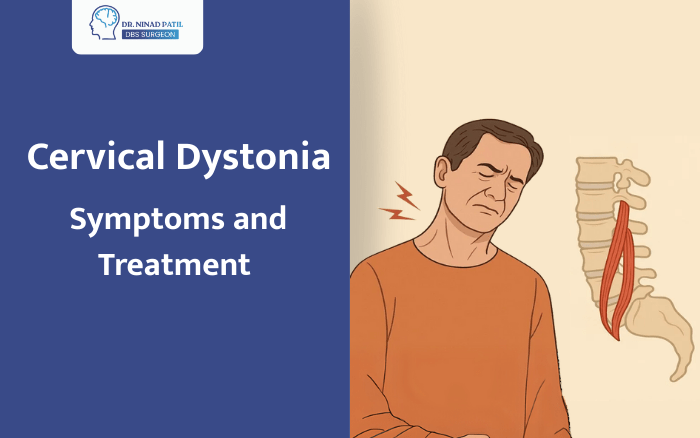Living with constant neck pulling, twisting, or jerking movements can feel confusing and exhausting. If you’ve noticed your neck turning in ways you can’t control, you may be dealing with cervical dystonia, also called spasmodic torticollis. While the condition is uncommon, it affects thousands of people worldwide and can cause daily challenges. The good part is that with the right treatment, many people find relief and learn to manage it well.
Let’s break down what cervical dystonia is, why it happens, and the treatment options available.
What is Cervical Dystonia?
Cervical dystonia is a neurological disorder that causes involuntary muscle contractions in your neck. These contractions force your head into abnormal positions, creating painful twisting, tilting, or turning movements that you cannot control.
Unlike regular neck pain from sleeping wrong or stress, cervical dystonia involves specific muscle groups that contract on their own. This condition is the most common type of dystonia, affecting about 16 people out of every 100,000.
Types of Cervical Dystonia
The condition appears in different forms depending on which direction your head moves:
- Torticollis: Your head turns to one side
- Laterocollis: Your head tilts toward your shoulder
- Anterocollis: Your head pulls forward toward your chest
- Retrocollis: Your head pulls backward
Many people experience a combination of these movements, making each case unique.
Recognizing Cervical Dystonia Symptoms
➣ Physical Symptoms
The main symptoms of cervical dystonia include:
- Involuntary neck muscle contractions that you cannot stop
- Head positioned in unusual angles
- Neck pain and stiffness that persists
- Shoulder pain, often with one shoulder higher than the other
- Muscle spasms that may come and go
- Head or hand tremors
➣ Daily Life Impact
These physical symptoms often lead to:
- Difficulty performing work tasks
- Problems driving safely
- Trouble sleeping due to muscle tension
- Frequent headaches
- Fatigue from constant muscle activity
- Social discomfort due to visible symptoms
What Causes Cervical Dystonia?
In most cases, doctors cannot identify a specific cause, which is called primary cervical dystonia. However, some known factors include:
➣ Primary Causes:
- Genetic factors (runs in some families)
- Brain chemistry imbalances
- Age-related changes (most common between ages 40-60)
➣ Secondary Causes:
- Head or neck injuries
- Certain medications
- Brain infections
- Other neurological conditions
Women are more likely to develop cervical dystonia than men, and symptoms typically begin in middle age.
How is Cervical Dystonia Diagnosed?
Diagnosis involves a thorough medical examination where your doctor will:
- Review your symptoms and medical history
- Observe your muscle contractions and head positioning
- Perform physical tests to assess neck movement
- Rule out other conditions with similar symptoms
In some cases, your doctor may order imaging tests like MRI scans to check for other causes of your symptoms.
➤ Know More About Dystonia
Treatment Options for Cervical Dystonia
Botulinum Toxin Injections
This is often the first and most effective treatment. Small amounts of botulinum toxin (commonly known as Botox) are injected directly into the affected neck muscles. The treatment:
- Blocks nerve signals that cause muscle contractions
- Provides relief for 3-4 minutes on average
- Requires repeat treatments to maintain benefits
- Works for about 90% of patients
➣ Oral Medications
Several medications can help manage symptoms:
- Muscle relaxants like baclofen help reduce muscle tension
- Anti-spasm medications can decrease involuntary movements
- Pain medications help manage discomfort
- Anxiety medications may help since stress often worsens symptoms
Physical Therapy
A structured therapy program can include:
- Specific exercises to strengthen weak muscles
- Stretching techniques to improve flexibility
- Posture training to reduce strain
- Heat and cold therapy for pain relief
- Techniques to manage daily activities more easily
Surgical Options
For severe cases that don’t respond to other treatments, surgical options include:
- Deep Brain Stimulation (DBS): Electrodes placed in specific brain areas to control abnormal signals
- Selective Denervation: Cutting specific nerves that control the overactive muscles
Living With Cervical Dystonia – Practical Tips
- Daily stretching can ease stiffness and improve mobility
- Heat or massage may reduce soreness
- Support groups help people connect with others facing the same challenges
- Good sleep and nutrition support overall health and may reduce symptom triggers
When to See a Specialist
If you notice persistent neck twisting, tremors, or pain that doesn’t go away, it’s time to consult a doctor. The sooner cervical dystonia is identified, the quicker you can begin treatment that helps control symptoms and improve quality of life.
Frequently Asked Questions
Q1: Is cervical dystonia curable?
There’s currently no cure, but treatments like Botox, medicines, and therapy can greatly reduce symptoms.
Q2: How long does Botox treatment last?
Most people experience relief for 3–4 months before needing another session.
Q3: Can stress make cervical dystonia worse?
Yes, stress and fatigue often trigger or worsen symptoms. Relaxation practices may help.
Ready to Manage Cervical Dystonia? Schedule Your Appointment Now
Living with cervical dystonia doesn’t have to mean living in constant discomfort. With the right diagnosis and treatment, symptoms can be managed and life can feel more normal again.
If you’re in Pune and looking for trusted medical help, you can book a consultation with Dr. Ninad Patil, Cervical Dystonia Specialist in Pune, at Alpha Superspeciality Clinics. His knowledge in diagnosing and treating movement disorders can guide you toward better control and relief.


